Faked Moon Landing
Questions arising from NASA's claim that it landed men on the Moon in 1969...
keywords: faked moon landing NASA Apollo
Did men did land on the Moon in 1969, as NASA claims? Some of the reasons for doubting that we have been given a genuine account of the Apollo Moon landings are as follows:
(1) The technology and expertise required to get man to the Moon and back is massively greater than that required to get into Earth orbit, or even to send an unmanned probe to Mars. If NASA were able to carry out five completely successful Moon landings thirty years ago, why is it barely able to get the space shuttle into orbit today? Funding now is less (but only about 50% so in real terms, according to The Economist magazine). In any case, this would only have slowed down further space exploration, not stopped it completely. Today we have technology that is many orders of magnitude more advanced than what was available in the 1960s. The computer in the Lunar Module had about the same power as a pocket calculator today. If they could do so much then, why can they do so little today? Moreover, why did every mission apart from Apollo 13 go perfectly? NASA has not had such a good track record either before or since.
(2) Photos apparently taken from the Moon (see links) show a substantial number of anomalies. The most basic are as follows:
a) Although the only source of light was supposed to be the Sun, many photos show shadows which are not parallel (for example, the shadows of two astronauts standing on flat ground are not parallel). This suggests a much closer light source.
b) Some photos show two light sources. In fact, all the photos look very much as though they were taken in the dark using very bright spotlights.
c) Some photos show artifacts. One shows a letter "C" carved on a rock; another shows a structure apparently floating in space a few metres above the ground.
A third photo shows two astronauts reflected in the visor of a third one. (Yet there were never supposed to be more than two people on the Moon at the same time).
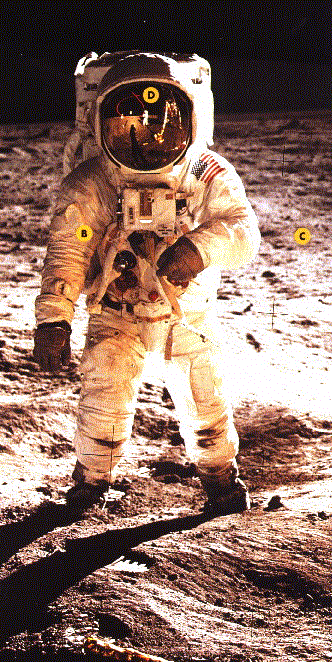
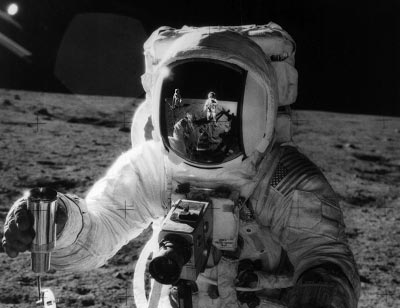
Other artifacts include a photo of the Lunar Rover with crosswires (supposedly from the camera that took the photo) which appear behind part of the photo. Other photos show crosswires at the wrong angle.
d) The first shots of Neil Armstrong landing were supposedly taken by a camera attached to one of the legs of the Lunar Module. Yet this camera cannot be seen in a photo taken shortly afterwards showing Buzz Aldrin walking down the ladder.

e) There is no crater, nor any sign of disturbance, under the Lunar Module. Yet its rockets would have blown dust and rocks away as it landed, and produced a crater.
f) There is no dust on the rocks. Since there is no air on the Moon, there should be just as much dust on the rocks as on the rest of the surface, since there is nothing to blow it away.
Note that all of these photos can be seen on-line or ordered through NASA www.nasa.gov. The links below discuss the photographic anomalies in much more detail.
g) There are no stars in any of the pictures. Stars are visible in pictures of space taken in Earth orbit, and are obviously visible from there. The only explanation that NASA gives is that it was "too bright". However, it is no brighter than it would be if you were in orbit around the Earth. Or maybe the problem is that it is harder to fake stars. (See discussion below).
h) On Earth, the atmosphere attenuates light, so that distant objects appear less sharp than objects close up. On the Moon, this would not happen. Yet several photos show backgrounds which disappear into the distance.
i) The lunar dust is totally dry. Yet the footprints look much like footprints on Earth: the moisture in the soil holds it together. On the Moon, the dust would not cling together, and any footprints would be much less well defined.
(3) Although they were apparently operating under one-sixth gravity (and should therefore have been able to jump six times as high as on Earth) there is no film showing them doing this. According to NASA, their backpacks and suits increased their weight so much that their overall weight was only twice that on Earth. Unless the backpacks were full of lead, this seems unlikely. In fact, there is no evidence that they could jump even twice as high as on Earth.
(4) The temperatures on the Moon would have been around 130 degrees Celsius in the sunlit places and -40 degrees Celsius in the shadows. A number of problems would have occurred:
a) the film would have either melted (in the heat) or snapped (in the cold). Unlike the astronauts, the cameras used were simply shielded from the Sun. The astronauts themselves apparently had special water-cooled spacesuits.
b) the visors would have cracked if they had been partly in a hot area and partly in a cold area (i.e., if a shadow fell across them).
c) most of the electrical equipment would have malfunctioned.
(5) The scenery on the moon looks very much like that in Nevada, where other evidence (see below) suggests that the film may really have taken place.
(6) One investigator has suggested that some of the experts which created the film "2001 a Space Odyssey" were recruited to work on the graphics for the NASA moon shot. The budget for this film jumped dramatically at just around this time.
Here are answers to a few questions that might be raised by this:
(1) What about the Moon rock?
Nothing has ever been produced that could not have been created on Earth.
(2) What about the laser reflector, which was apparently placed on the lunar surface, and which has been used by scientists to measure the exact distance to the Moon?
All the data has been controlled by NASA.
(3) How come information about this has been kept secret?
There have been several reports of leaks. For example:
(a) Prostitutes in Las Vegas have been interviewed, and have claimed that they had "astronauts" as clients who were working on the "film set" used by NASA.
(b) A pilot reported seeing the Command Module being thrown out of a plane with a parachute, a few minutes before it landed in the sea.
Some investigators believe that the crudity of some of the mistakes (for example, in the photos) suggests that they were deliberate. Other important projects, such as the Manhattan project, which developed the first atomic bombs, was also kept secret. $30 billion (see below) buys a lot of secrecy.
There would have been no reason for more than a handful of people to have known the true nature of the project. For example, the Saturn V launch vehicle had to be designed, built and launched regardless of whether it contained astronauts or not. All signals from the astronauts were received by one part of the organisation and analysed by other parts. It would not have been difficult to fake a few conversations with astronauts and readings from the spacecraft's instruments.
This technique, by which a large organisation carries out a project, but only a very small number of people know what is really going on, has been used in many other situations.
(4) Why didn't the Soviets point this out?
There could be a number of reasons. We don't know the true state of the relationship between the USSR and the time: to what extent was the Cold War real, and to what extent was it created by the Industrial-Military complex to justify spending on arms? Maybe there was co-operation at some levels between the USA and the USSR. Maybe the Soviets never found out. Maybe they did find out, and they kept quiet in exchange for the Americans keeping quiet about something else.
(5) What was the reason for this?
Money and prestige. The Americans' first Apollo mission, Apollo 1, ended in the death of three astronauts on the launchpad. According to one theory, NASA then commissioned a report which showed that it was extremely unlikely that a lunar mission would succeed (the person writing this report subsequently had an "accident".) However, JFK had already publically committed the country to going to the Moon. They therefore decided to use the approx. $30 billion (in today's terms) to fake the landing and save face. $30 billion provides a pretty big incentive, as does the desire to save face in front of the rest of the world.
(6) What about the fact that we saw the astronauts getting into the rocket and getting out of the Command Module when it landed in the ocean?
It would hardly have been that difficult to find a way to get the astronauts out of the rocket without being seen. They were several hundred metres in the air, and NASA controlled all access and television pictures. In the case of the Command Module landing, see above.
(7) The American government is democratic, and would never lie to the people on such a large scale.
The American goverment has a track record of lying to its people. There is no reason whatsoever to take anything which it says at face value. NASA is a government organisation with close links to the military.
Links to photos and further analysis
The following document can be seen in essentially the same form on different web-sites:
https://www.angelfire.com/ut/aylett/eth69.html
The second document is an article which appeared in Fortean Times (number 94). It is written by David Percy, an award winning film and TV producer:
www.think-aboutit.com/fakemoon.html
This document discusses two arguments: first, that shadows of objects in the NASA photos are not parallel to each other, as they would be if they were lit just by the Sun. Second, that the landscape darkens towards infinity, which would happen on Earth but not on the Moon (because there is no atmosphere on the Moon).
A later issue of Fortean Times, number 97, included a rebuttal of many of the points made in the earlier article.
www.forteantimes.com/artic/97/moon.html
However, it doesn't really answer all of the points. The author suggests that the reason why some of the shadows are not parallel is because the photos were taken with short-angle lenses. However, this would produce a completely different kind of distortion. With a short-angled lens, the shadows would be displaced in proportion to their distance from the straight-ahead position: in other words, objects at the far left or the far right of the picture would have the most distortion (i.e., the angles of their shadows would be displaced by the greatest angles). Take, for example, this photograph.
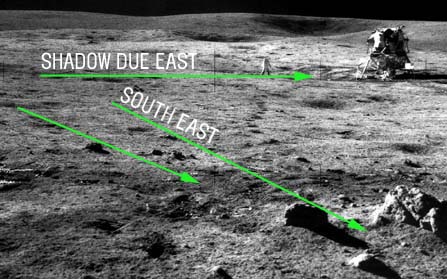
Look at the shadows in the foreground on the left of the picture and compare them with those in the foreground on the right of the picture. If this photo had been taken using a short-angled lens, there would be a gradation of angle distortion centred on the straight-ahead position. In other words, shadows to the extreme left and the extreme right would be distorted in opposite directions (the first counter-clockwise, the second clockwise). Instead, there is no difference. On the other hand, there is a difference between the shadows in the foreground and those in the background.
Another, even stronger, argument made by David Percy is that the angle which the Sun make to the horizon is simply incorrect. For example, in this example from Apollo 11, "the sun was at 10 degrees above the horizon but the pictures depict 30 degrees or so!"
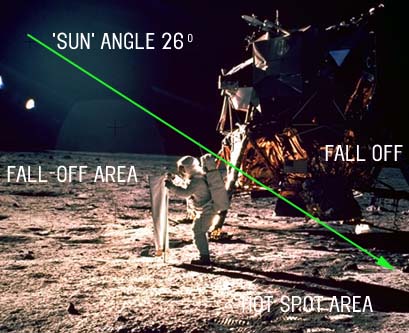
Note also that in this picture the background rapidly darkens. This looks very much like a picture taken at night with a bright spot light suspended up in the air. It does not look very much like like the surface of a body which is lit up only by the Sun.
What does NASA say about all this?
There is nothing on the NASA site www.nasa.gov, and their press office refuses to discuss the issue (New Scientist, July 17 1999, p.49). One would have thought that, if they really did have explanations for the anomalies they would be happy to give them.
The following document, cited in the New Scientist article mentioned above, is an interview with aviation writer and systems engineer Larry Jacks. It answers a few of the points; but Jacks refuses to discuss most of the photographic evidence. www.skywardpress.com/acritique_video.htm
One response from NASA came in 1991, when a newspaper ran a headline news story about the idea that the Moon landings were faked. NASA rebutted some of the points made in the article.http://tommy.jsc.nasa.gov/~woodfill/SPACEED/SEHHTML/hoax.html. Unfortunately, while this answers some of the questions, others are left unanswered. In particular, there is still no credible answer to the question of why stars are not visible in the pictures. NASA's answers are:
a) because they are out of focus and
b) because stars are not visible in daylight on Earth, either.
Several of their photos show mountains in the distance which are clearly in focus. For example:
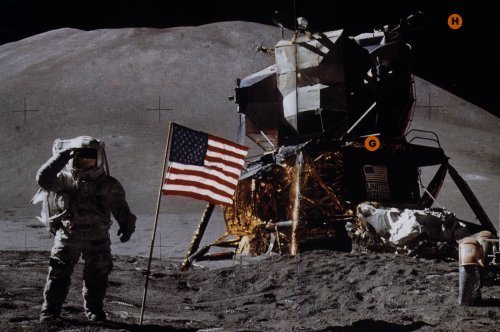
In any case, with such bright light the depth of field would include objects at infinity in most of the shots. There is consequently no evidence for a).
Argument b) is ridiculous. Stars are not visible on Earth during the daylight because sunlight is scattered by particles in the atmosphere. There is no atmosphere on the Moon, so this wouldn't happen.
This web-site was produced in Prague by Animal Design.
If you have any comments, feedback or other interesting evidence, please e-mail me at fakedmoonlanding@operamail.com. I am particularly interested in hearing about any plausible alternative explanations for the points mentioned on this site.